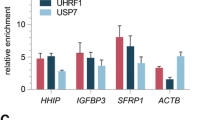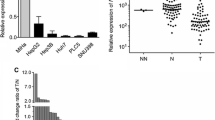Abstract
Background/Purpose of the study
Despite tremendous progress in therapy, about 30 % of patients with hepatoblastoma still succumb to the disease. Thus, the development of improved therapies as well as the identification of prognostic factors are urgently needed.
Methods
In the present study, expression and promoter methylation of the N-myc downstream-regulated gene (NDRG2), a tumor suppressor gene contributing to the regulation of the Wnt signalling pathway, was analysed in 38 hepatoblastoma samples by real-time reverse transcription-PCR and pyrosequencing, respectively.
Results
The NDRG2 gene was highly expressed in normal pediatric liver tissue, but was significantly downregulated in heptoblastoma primary tumors. Detailed methylation analysis of CpG sites in the NDRG2 promoter region revealed a general high degree of DNA methylation in hepatoblastoma, which correlated with the suppression of NDRG2. By analyzing clinicopathological features we could demonstrate a strong association between low NDRG2 expression and tumor metastasis. Importantly, the overall survival analysis by Kaplan–Meier revealed that high NDRG2 expression was correlated with a higher survival rate in hepatoblastoma patients.
Conclusion
Our data show that downregulation of NDRG2 may play an important role in advanced hepatoblastomas.



Similar content being viewed by others
Abbreviations
- HB:
-
Hepatoblastoma
- HCC:
-
Hepatocellular carcinoma
- CTNNB1:
-
Catenin beta 1
- NDRG2:
-
N-myc downstream-regulated gene 2
- SIOPEL:
-
Childhood liver tumors strategy group
- GPOH:
-
Society for pediatric oncology and haematology
- LTR:
-
Liver tumor registry
- RT-PCR:
-
Quantitative real-time PCR
- TBP:
-
TATA-Box-binding-protein
- CpG:
-
Cytosine-phospho-guanine
References
Lopez-Terrada D. Hepatoblastoma: new insights into the biology of embryonal tumors of the liver. In: Mackinnon Jr. A, editor. Pediatric neoplasia: advances in molecular pathology and translational medicine, molecular and translational medicine. New York: Springer Science + Business Media; 2012. p. 243
Darbari A, Sabin K, Shapiro C, Schwarz K. Epidemiology of primary hepatic malignancies in US children. Hepatology. 2003;38(3):560–566
Weinberg A, Finegold M. Primary hepatic tumors of childhood. Hum Pathol. 1983;14(6):512–537
Lopez-Terrada D, Finegold M. Tumors of the liver. In: Liver disease in children. New York: Cambridge University Press. 2007, p. 943–975
Haeberle B, von Schweinitz D. Treatment of hepatoblastoma in the German cooperative pediatric liver tumor studies. Front Biosci (Elite ed.). 2012;4:493–498
Perilongo G, Shafford E, Plaschkes J. SIOPEL trials using preoperative chemotherapy in hepatoblastoma. Lancet Oncol. 2000;1:94–100
Malogolowkin M, et al. Complete surgical resection is curative for children with hepatoblastoma with pure fetal histology: a report from the children’s oncology group. J Clin Oncol. 2011;29(24):3301–3306
Eichenmüller M, et al. The genomic landscape of hepatoblastoma and their progenies with HCC-like features. J Hepatol. 2014;61(6):1312–1320
Koch A, et al. Childhood hepatoblastomas frequently carry a mutated degradation targeting box of the beta-catenin gene. Cancer Res. 1999;59(2):269–273
Oda H, et al. Somatic mutations of the APC gene in sporadic hepatoblastomas. Cancer Res. 1996;56(14):3320–3323
Taniguchi K, et al. Mutational spectrum of beta-catenin, AXIN1, and AXIN2 in hepatocellular carcinomas and hepatoblastomas. Oncogene. 2002;21(31):4863–4871
Deng Y, et al. N-Myc downstream-regulated gene 2 (NDRG2) inhibits glioblastoma cell proliferation. Int J Cancer. 2003;106(3):342–347
Lusis E, et al. Integrative genomic analysis identifies NDRG2 as a candidate tumor suppressor gene frequently inactivated in clinically aggressive meningioma. Cancer Res. 2005;65(16):7121–7126
Hwang J, et al. Crystal structure of the human N-Myc downstream-regulated gene 2 protein provides insight into its role as a tumor suppressor. J Biol Chem. 2011;286:12450–12460
Zhou R, et al. Characterization of the human NDRG gene family: a newly identified member, NDRG4, is specifically expressed in brain and heart. Genomics. 2001;73:86–97
Qu X, et al. Characterization and expression of three novel differentiation-related genes belong to the human NDRG gene family. Mol Cell Biochem. 2002;229:35–44
Choi S, et al. Expression and regulation of NDRG2 (N-myc downstream regulated gene 2) during the differentiation of dendritic cells. FEBS Lett. 2003;553:413–418
Hu X, et al. NDRG2 expression and mutation in human liver and pancreatic cancers. World J Gastroenterol. 2004;10:3518–3521
Li N, et al. Combined aberrant expression of N-Myc downstream-regulated gene 2 and CD24 is associated with disease-free survival and overall survival in patients with hepatocellular carcinoma. Diagn Pathol. 2014;9:209
Zheng J, et al. NDRG2 inhibits hepatocellular carcinoma adhesion, migration and invasion by regulating CD24 expression. BMC Cancer. 2011;251:1–9
Liu N, et al. Promoter methylation, mutation, and genomic deletion are involved in the decreased NDRG2 expression levels in several cancer cell lines. Biochem Biophys Res Commun. 2007;358:164–169
Eichenmüller M, et al. Blocking the hedgehog pathway inhibits hepatoblastoma growth. Hepatology. 2009;49:482–490
Tost J, Gut IG. DNA methylation analysis by pyrosequencing. Nat Protoc. 2007;2(9):2265–2275
Yamamura A, et al. Suppressed expression of NDRG2 correlates with poor prognosis in pancreatic cancer. Biochem Biophys Res Commun. 2013;441(1):102–107
Nakahata S, et al. Loss NDRG2 expression activates PI3K-AKT signalling via PTEN phosphorylation in ATLL and other cancers. Nat Commun. 2014;5:3393
Tomlinson G. Cytogenetics of hepatoblastoma. Front Biosci (Elite ed.). 2012;4:1287–1292
Weber R, Pietsch T, von Schweinitz D, Lichter P. Characterization of genomic alterations in hepatoblastomas. A role for gains on chromosomes 8q and 20 as predictors of poor outcome. Am J Pathol. 2000;157(2):571–578
Lee D, et al. Functional and clinical evidence for NDRG2 as a candidate suppressor of liver cancer metastasis. Cancer Res. 2008;68(11):4210–4220
Choi S, et al. Expression of NDRG2 is related to tumor progression and survival of gastric cancer patients through Fas-mediated cell death. Exp Mol Med. 2007;39:705–714
Polakis P. Wnt signaling and cancer. Genes Dev. 2000;14:1837–1851
Kim A, et al. Suppression of NF-kappaB activity by NDRG2 expression attenuates the invasive potential of highly malignant tumor cells. Carcinogenesis. 2009;30:927–936
Kim J, et al. NDRG2 and PRA1 interact and synergistically inhibit T-cell factor/β-catenin signaling. FEBS Lett. 2012;586(22):3962–3968
Kim Y, et al. NDRG2 expression decreases with tumor stages and regulates TCF/beta-catenin signaling in human colon carcinoma. Carcinogenesis. 2009;30:598–605
Shon S, et al. Bone morphogenetic protein-4 induced by NDRG2 expression inhibits MMP-9 activity in breast cancer cells. Biochem Biophys Res Commun. 2009;385:198–203
Du Q, Geller D. Cross-regulation between Wnt and NF-κB signaling pathways. For Immunopathol Dis Therap. 2010;1(3):155–181
Acknowledgements
This work was supported by grants from the Friedrich Baur Foundation, Munich, Germany (to J.G.), the Bettina Bräu foundation, Munich, Germany and the Gänseblümchen-Voerde foundation, Voerde, Germany (to R.K.). We are grateful to Fatemeh Promoli for technical assistance.
Author information
Authors and Affiliations
Corresponding author
Ethics declarations
Conflict of interest
Jan Gödeke, Elke Luxenburger, Franziska Trippel, Kristina Becker, Beate Häberle, Josef Müller-Höcker, Dietrich von Schweinitz and Roland Kappler declare that they have no conflicts of interest.
Ethical standards
All procedures followed were in accordance with the ethical standards of the responsible committee on human experimentation (Institutional and National) and with the Helsinki Declaration of 1975, as revised in 2008. This study was reviewed and approved by the ethics committee of the Medical Faculty at the University of Munich, Germany. All samples were taken with informed consent of the donor’s parents.
Rights and permissions
About this article
Cite this article
Gödeke, J., Luxenburger, E., Trippel, F. et al. Low expression of N-myc downstream-regulated gene 2 (NDRG2) correlates with poor prognosis in hepatoblastoma. Hepatol Int 10, 370–376 (2016). https://doi.org/10.1007/s12072-015-9686-1
Received:
Accepted:
Published:
Issue Date:
DOI: https://doi.org/10.1007/s12072-015-9686-1




